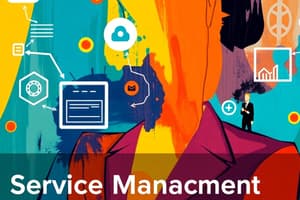Podcast
Questions and Answers
What is the key difference between outputs and outcomes in the context of a service?
What is the key difference between outputs and outcomes in the context of a service?
- Outputs refer to the specific deliverables of a service, while outcomes refer to the intended results or impacts of the service. (correct)
- Outputs refer to the internal processes used to deliver the service, while outcomes refer to the external benefits experienced by customers.
- Outputs refer to the customer's satisfaction with the service, while outcomes refer to the service provider's ability to meet its service level agreements.
- Outputs refer to the level of service provided, while outcomes refer to the financial performance of the service provider.
Why is it important for a service provider to track changes in customer expectations?
Why is it important for a service provider to track changes in customer expectations?
- To demonstrate that the service provider is delivering a consistent level of service.
- To ensure that the service provider is maintaining a high customer satisfaction rating.
- To ensure that the service provider is meeting its service level agreements.
- To enable the service provider to adapt its services to meet the changing customer environment. (correct)
What is the relationship between a service provider's ability to meet its service level agreements and its customer satisfaction rating?
What is the relationship between a service provider's ability to meet its service level agreements and its customer satisfaction rating?
- A service provider's customer satisfaction rating is only important for external customers, not internal customers.
- A service provider that consistently meets its service level agreements will always have a high customer satisfaction rating.
- A service provider that consistently meets its service level agreements may still have a low customer satisfaction rating. (correct)
- A service provider's customer satisfaction rating is not related to its ability to meet service level agreements.
What is the role of ITIL Service Strategy in understanding how customer expectations change and how a service provider can adapt its services?
What is the role of ITIL Service Strategy in understanding how customer expectations change and how a service provider can adapt its services?
How does the text suggest that the way services are designed, transitioned, delivered, and improved is different for internal and external customers?
How does the text suggest that the way services are designed, transitioned, delivered, and improved is different for internal and external customers?
What is the key reason why a service provider must provide the same agreed level of service to both internal and external customers?
What is the key reason why a service provider must provide the same agreed level of service to both internal and external customers?
How does the text suggest that a service provider's focus on outputs rather than outcomes can lead to issues?
How does the text suggest that a service provider's focus on outputs rather than outcomes can lead to issues?
What is the key interdependency between a service provider's internal and external customer-facing services?
What is the key interdependency between a service provider's internal and external customer-facing services?
How does the text suggest that service level agreements (SLAs) are related to customer satisfaction?
How does the text suggest that service level agreements (SLAs) are related to customer satisfaction?
Flashcards are hidden until you start studying




